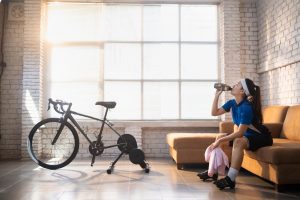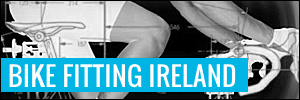As a former rider for many years and a Cycling Coach for over 20 years having worked with all levels of riders from Leisure riders, Juniors and Elite racing cyclists I have seen the benefits of the use of indoor trainers, however I have also seen the major pitfalls that can come with the over use of them.
During this lockdown the past few months, I can certainly see how they have been a life saver for a lot of riders who are unable to go outside for good spins and are at least able to keep their bodies fit and their heads fit by being able to do some sort of training.

I had personal experience myself as a rider in the early 90’s when I badly broke my arm racing and was unable to ride the bike outdoors. However with the use of an indoor trainer a few times a week combined with a lot of walking! I was able to keep fit and sane for 6 weeks and the first race I returned to I actually finished 2nd in. It was also with the help of a great coach at the time (Paddy Doran Peak Endurance Coaching) who kept me from over doing things.
However I have also seen the big downsides to the over use of indoor training and as a Bikefitting professional and Neuromuscular Therapist I regularly see riders with injuries or cycling related issues that have happened directly from the overuse of indoor trainers. In this COVID 19 lockdown I have received phone calls and emails every single day from riders who are struggling with certain issues and when I question them more I have discovered they are spending hours everyday on the indoor trainers which is significantly contributing towards their issues.
Below I have listed the benefits and drawbacks of indoor training and a lot of the issues and problems I see with their overuse or bad set up. I have listed some of the things you can do to avoid a lot of the issues.

Indoor trainers are absolutely brilliant and a great training tool when used correctly but they are never a real substitute to real outdoor training and experiences.
Indoor Trainers:
Benefits:
- Great when the weather is very bad or dangerous to go out in like ice or storms. Or lockdowns!
- Great when your time is very limited with work or family
- Great for the dark nights during the winter safer than being on the roads in the dark
- Great for doing very specific work and interval training
- Great for coming back from certain injuries where its too risky to go out on the road or impossible to control the bike on the road e.g. broken collarbone or wrist.
- Great for groups to get together in a hall during the winter and train together.
Drawbacks:
- Can be pretty boring, time passes very slowly on an indoor trainer and it can be very hard to motivate yourself to do an indoor session.
- You get very hot even with windows open and a fan on. Your heart has to work very hard just to keep you cool let alone the exercise you are doing.
- The bike is very static in an indoor trainer, there is no left or right movement or handlebar movement like you get on the road. On top of this there is little or no freewheeling on an indoor trainer so the pedalling is constant, unlike out on the road where you freewheel down hills, stop at junctions, get out of the saddle etc. This can lead to a lot of overuse injuries.
- Many riders I see who spend too long on indoor trainers too regularly have poor skill levels out on the road. They are not getting enough practice of real life situations.
- Again riders who spend too much of their cycling time on an indoor trainer find it hard to climatise to the real life weather conditions and often dress wrongly outdoors.
- Dehydration can be a big issue for a lot of riders. A lot of riders don’t drink enough in general even out on the road, its even more important to drink plenty on an indoor training session.
- On a non direct drive indoor trainer where you use your own bikes back wheel, you will need a special indoor trainer tyre as the friction from the roller will wear your tyre very quickly. Its also hard on carbon frames, some manufacturers recommend that you don’t use your carbon bike on an indoor trainer.

A lot of the issues I regularly see with riders who spend too long on an indoor trainers are:
- Saddle sores, this can be very common. Because of the static nature of the bike in the trainer with no movement you are stuck in the one position all the time and with the constant pedalling action with very little freewheeling and combined with the heat and sweat especially in the seated area a lot of riders can suffer with all kinds of saddle sores. Also if the bike is not level in the trainer you can slip back and forth in the saddle too much.
- Perineum numbness (numb soft tissue area underneath at the front of the saddle)
- Sit bone pain (pain at the back of the saddle.)
- Knee pain. Again because of the constant pedalling action and very little freewheeling there is a lot more pressure in the knee joints and attachments. The most common knee problems I see are;Patella Tendon pain (generally pain at the front of the knee)
- IT Band issues. (Generally pain at the lower outside of the knee)
- Sore / Numb/ Pins and needles in the hands. With the non movement of the bike and the static nature of the position of the rider on the bike sore hands can be a big issue also this can be caused by the bike not being level therefore pushing the rider forward onto the handlebars too much.
- Lower back pain. Generally from spending too long on the turbo at too high an intensity.
- Sore toes or feet. Because of the constant pedalling action and the heat generated indoor and lack of movement on the bike.
- Burn out and general lack of motivation of riders when their main events come along. This is generally because of doing too much, too long at too high an intensity too regularly on the indoor trainer.
- One unusual issue I see, is with riders who have poor flexibility especially in the hip, hamstring and lower back area. They find it very hard to get on and off the bike. This is because they cannot tilt the bike over like outdoors to get on as it is fixed upright in the indoor trainer. I know it sounds funny but it can be dangerous especially for these riders getting off the bike.

Some tips to help over come some of the above issues:
- Have the room cooled down 10-15 mins before you start. So leave the windows open and have a fan running before you start.
- Drink at least 750ml of water during a 1 hour session indoors
- Put a towel across the handlebars to catch sweat and wipe yourself when training.
- Make sure the bike is level. You may need to put a wheel riser under the front wheel so that you don’t slip forward therefore putting pressure on your hands and also creating saddle friction.
- Stand up out of the saddle regularly during the session to ease the pressure in the seated area and use a good pair of shorts.
- Dress lightly for the session, you wont need to wear a jersey indoor training you will be too warm.
- Keep sessions to max 1 hour, you are not getting any benefits from doing marathon indoor sessions. You can get a lot from 1 hour and its better for you head!
- Keep the number of sessions you do in a week to a minimum if you can and make sure you get out on the road at least once a week to keep your cornering, descending and group cycling skills up to scratch.
- Mix up your sessions. So don’t just sit on the indoor trainer and pedal for an hour, do lots of different things every few minutes, this will make the time go quicker.
- Don’t do high intensity sessions every time. Make sure you have easy days. Otherwise you will burn out or get sick of the turbo very quickly. HIIT (High Intensity Interval Training) have become very fashionable the past few years, however in the long term you won’t last in cycling. You will get most benefit from lower intensity training and mixing some High Intensity work once a week instead of every session.

- Move your hands regularly on the handlebars to change their position every few minutes to help avoid numbness.
- For riders who have poor flexibility and struggle to get on and off the bike in the indoor trainer it’s a good idea to have a little step beside the bike. You can get these in any child care store, you can get a POTTY step you use for a toddler to reach the toilet!
- If your about to purchase an indoor trainer, its worth spending the extra and get yourself a direct trainer. You don’t need to use the back wheel of your own bike also they are smart trainers so you can hook up to some great interactive cycling apps.
- Studies have shown, including a great study by our very own Tadgh McIntyre (Clinical and Sports Psychologist) that the use of outdoor colours ie Greens, Blues or pictures of nice outdoors scenes placed around yourself helps your mood while indoor training.
- There are some great APPs to use such as Zwift or my personal favourite Rouvy to use with your smart trainer. These give you routes to ride and control the resistance on your trainer as you climb hills or ride on the flat. You also get the opportunity to ride with other riders on the same route. You just have to be careful again not to do big hours or high intensity all the time.
Indoor training can be great and very beneficial once you don’t over do it. So enjoy and hope you are all back on the roads in the very near future!
Aidan Hammond
Level 3 Cycling Ireland Coach and Coach Tutor
Neuromuscular Physical Therapist
Qualified professional Bikefitter




